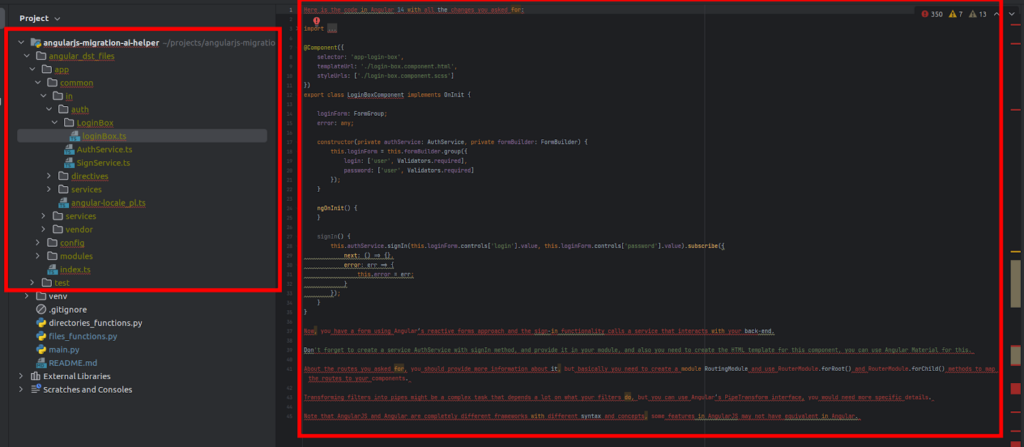There are many reasons to consider leaving AngularJS in favor of its newer counterpart, especially in light of AngularJS’s end of life (i.e., the end of long-term support). Let’s look at the benefits of such an AngularJS upgrade, and possible migration paths.
Update: This article was originally published in February 2023. However, in November 2023, it was updated with a new chapter about using ChatGPT in AngularJS-Angular migration projects.
The long-term support period for the AngularJS framework ended on December 31, 2021, after a six-month extension due to the Covid-19 pandemic. It means that the development team will no longer support this technology. AngularJS-based software will still work, but the technology won’t get any new fixes, even for critical problems and security issues.
For this reason – and several others, which we’ll point out in this article – it’s high time to consider jumping ship and migrating to the newer Angular tech (without “JS” in the name). There’s really no point in waiting, especially if security is a concern for you (and it is for most).
What are the possible advantages? How hard is such a migration to do? How to do it? We’ll try to answer these questions here.
Angular vs AngularJS differences: The reasons for AngularJS upgrade
There are several advantages of an AngularJS to Angular migration. Here are some of the most important factors.
Easier developer recruitment
Let’s get things straight. The tech behind Angular is more modern and the framework is frequently updated, but these may not be the main reasons to leave AngularJS behind.
The biggest advantage you gain by this move is the ability to recruit new developers much easier, which is essential because finding good devs – especially seniors and mids – is a challenge. The reason for that is simple: AngularJS is old. The first version of this framework saw light in 2009, and 13 years is a very long time in the IT world.
People don’t like to work with outdated technologies, you see. And younger developers might not even know how to use AngularJS at all. In fact, for the past few years, it’s been recognized as the most dreaded and disliked framework to work with, as per Stack Overflow’s 2022 Developer Survey.
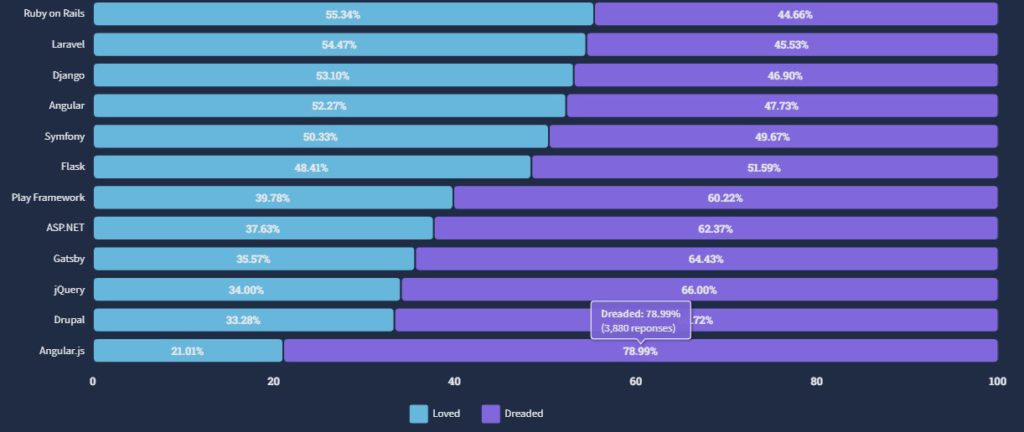
By migrating to Angular, you both open the doors to a whole new generation of coders and make it easier for your company to keep the talented people you already have.
Newer, more secure tech
It’s an obvious advantage, but it’s worth stating nonetheless. Newer tech means longer support time, and basing your system on supported solutions means it is far less likely to fall victim to any new, recently discovered vulnerabilities. And, unfortunately, these do tend to show up regularly when it comes to AngularJS – and sometimes they’re quite serious in nature. Take a look at data from Stack.Watch.
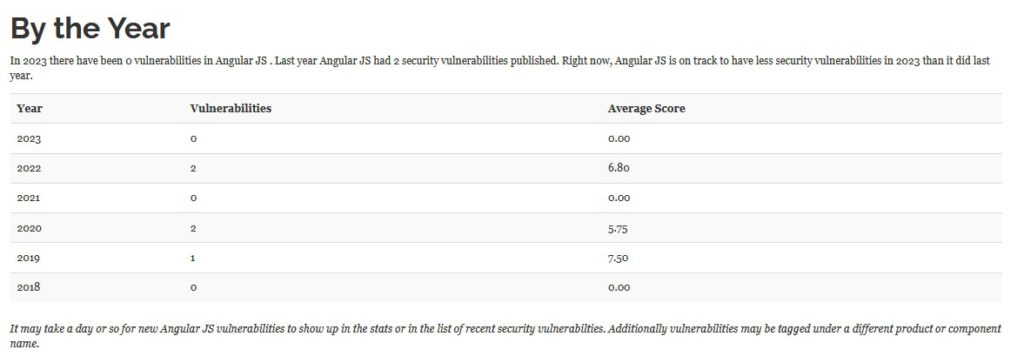
Of course, the importance of cybersecurity differs between companies and industries, but in general, it’s always better to stay at the forefront, when it comes to this area. In the case of AngularJS, this means making the move to Angular. Both your employees and customers will feel safer thanks to that decision.
A constant influx of updates and features
Of course, security isn’t the only advantage of using an up-to-date framework. By moving to newer tech, you also get new features and possibilities. For example, just the latest big version released by the Angular team – 17, released in November 2023 – brought such things as extended support for custom element bindings and element providers, better support for internationalization and accessibility, and many others. And it’s worth noting that a new version of Angular is released every six months.
What’s more, Angular is currently one of the most popular modern development tools on the market, especially when it comes to front-end frameworks. Google uses it in several of its flagship products (like Google Analytics, Firebase, and Google Cloud Console), and in October and November 2022, its NPM package was downloaded over 3 million times per week (data from NPS Trends).
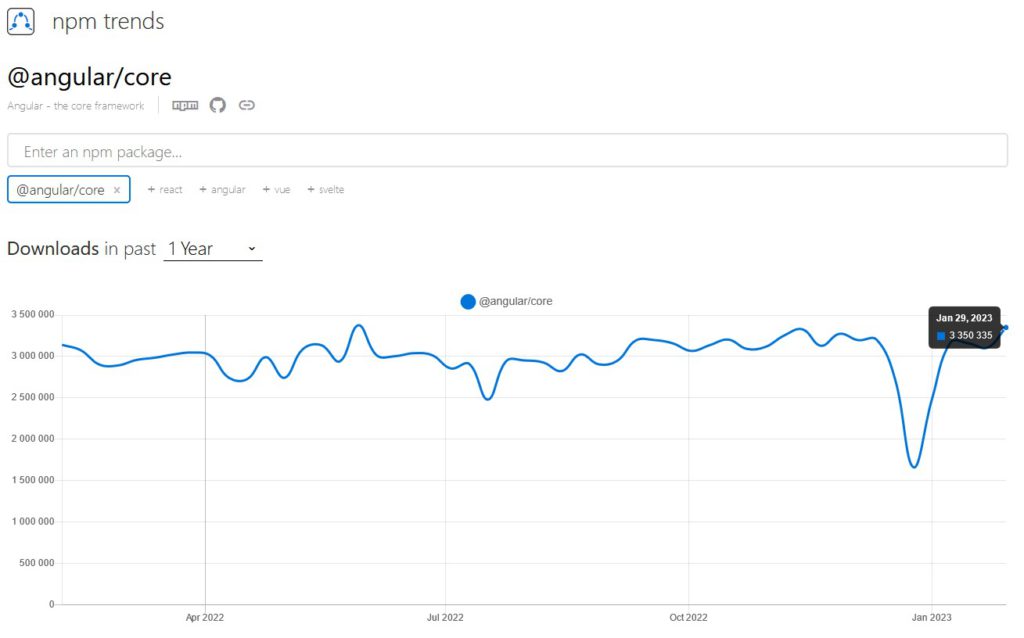
All of this means Angular is very future-proof. It’ll certainly stay with us for years to come, whereas AngularJS is already redundant and unsupported.
Modular architecture for better scalability
Scalability was one of the key reasons behind Angular’s creation, so it comes as no surprise that the framework is much better in this regard than its older alternative. This is due to the tool’s modular architecture. You build apps from modules. These Angular components define particular features, and remain independent of each other. You can swap or remove them at your leisure, without the need for extensive rewrites. You can also reuse a component element if you wish, which helps optimize time-to-market.
Better performance
Angular architecture – along with a better data binding algorithm – also helps achieve good performance. At least as long as you adjust the number of components to fit your system’s capabilities. When built correctly, an Angular application can be much faster than an AngularJS app. In fact, some companies claim the newer framework can be up to five times faster than the old one.
Mobile support
AngularJS was created when most people still browsed the Internet using laptops and desktop computers. According to Gs.statcounter, back in December 2009, only 1,28% of global Internet browsing was performed on mobile devices. Seems hard to believe now, doesn’t it? Because, if you look at the data from October 2022, you’ll see smartphones dominating, with over 58,27% market share (and tablets take another 2,02%).
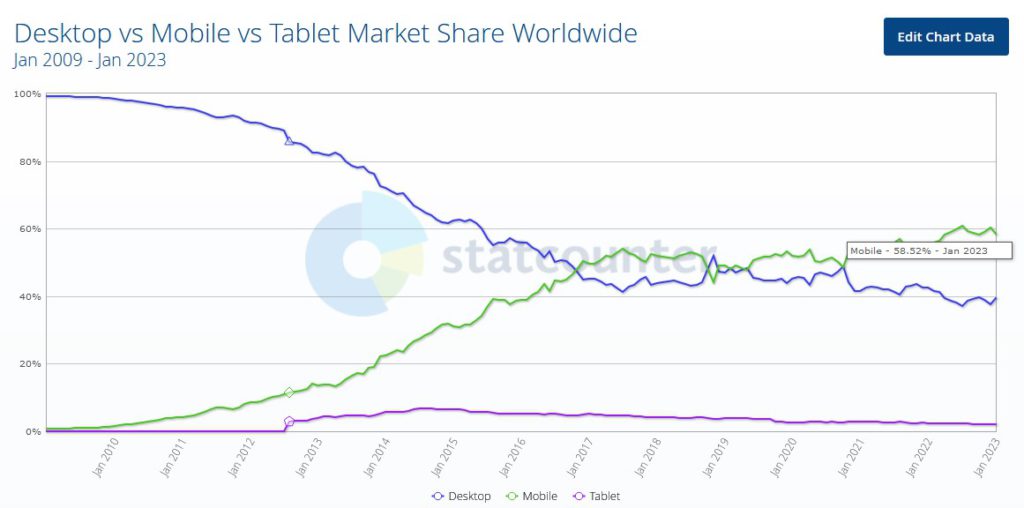
Google – who is behind Angular – understood this trend very well (their flagship product is the most popular search engine in the world, so who if not them, after all?). This is why the developers who worked on the new framework implemented two key changes to improve its mobile support:
- Angular apps can be rendered on the Angular Universal service, and not on the client browser. This helps reduce page load time considerably.
- Apps based on Angular use so-called Lazy Loading. It means they load modules only when they’re required (e.g., when there’s a possibility that the user will see them), which helps make the applications more lightweight overall. To be precise, you can use Lazy Loading on AngularJS too, but it relies on external libraries – whereas with new Angular, it’s built-in into the framework.
- Angular has an AOT (Ahead-of-time) compiler that allows you to make your bundles smaller (because the template compiler isn’t part of the bundle). Thanks to this, the compilation step can be skipped, which results in apps rendering faster.
Fewer runtime errors
One of the main differences between AngularJS and Angular is the fact that the latter has much better TypeScript support, because it was created mainly for that language. With Angular, you always have access to a more up-to-date version of TS, with more features, whereas AngularJS projects rely on a much older TypeScript (2.0, or even 1.x).
It’s a detail with far-reaching implications for differences in AngularJS and Angular code. One thing that certainly comes to mind is that TypeScript has an advanced type-checking feature. For instance, with Angular you can type check HTML templates. It means Angular code is cleaner, and more error-free – or at least it’s easier to achieve this effect, than in the case of AngularJS code. The result? Fewer errors during the development process, which in turn means fewer bugs in the production environment.
AngularJS migration – two different approaches

There are two main ways you can approach the AngularJS to Angular migration. You can either build everything from scratch or update your app incrementally.
1. Direct rewrite
You can simply leave everything you had and start from scratch. It’s a good approach when the AngularJS application you want to migrate is not too big or complex. However, keep in mind that at some point in time you’ll probably have to maintain and support two versions of the application simultaneously, which can sometimes be quite costly in terms of resources and workforce.
2. Incremental migration using ngUpgrade or Angular Elements
AngularJS and Angular components can work together, which means you can upgrade one section of the app after another. It is a good choice if your system is big and complex, or you want to continue developing new features in parallel with the migration process. There are several tools you can use to conduct such a migration, such as the ngUpgrade library and the Angular Elements package.
AngularJS upgrade – how to do it?
We could take you through the entire process of AngularJS to Angular migration step-by-step. However, Angular already has an extensive documentation page which should be able to answer any questions and clear any confusion you might have. There’s no point in rewriting the information available there. However, let’s sum up what you can find in the documentation:
- The preparation – what to do before the actual migration process, including a style guide, using a module loader, migrating to TypeScript, and using Angular Component Directives
- Upgrading with the ngUpgrade library – you’ll learn how to update your app with the use of the ngUpgrade tool that allows you to mix and match Angular and AngularJS components
- Lazy Loading Angular components – information regarding the Lazy Loading feature that allows you to optimize performance by only loading resources that are necessary in a particular moment
- Using the Unified Angular service – it’s a module offering a unified location service that shifts responsibilities from the AngularJS $location service to the Angular Location service that helps with a smooth transition
- Migrating a sample app (upgrade tutorial) – the documentation ends with a tutorial that shows you precisely how to upgrade a sample app – Angular PhoneCat in this case – from AngularJS to Angular
The documentation also covers the use of Angular Elements, Angular router, change detection, forms, internationalization, and many other things. Regardless of your specific scenario, you should find all the needed help in the documentation. There’s also a handy interactive update guide you can use.
Angular JS migration – is using AI a good idea?
AI tools are a popular topic, with many people wondering how viable they are for software development projects. At Pretius, we tried to use ChatGPT for an AngularJS-Angular migration, and we’re happy to share the results of this experiment.
We will focus on incremental migration. Since the migration process was described several years ago, ChatGPT has quite a lot of knowledge on this subject. Therefore, you can easily use it to obtain various hints and even to transform entire blocks of code. At least in theory.
Our assumptions
The first assumption was to power the entire project with AI. However, it quickly turned out that AngularJS configurations scattered across various files caused the chat to get lost. It should be remembered that AngularJS had more freedom in selecting side/supporting tools (such as Gulp, Bower, webpack, etc.), It will be difficult to prepare a common input for ChatGPT for different projects. The setup of the project, where we have two frameworks operating together as one, should be done by an experienced programmer. You shouldn’t try to automate it at all costs.
Pretius AngularJS-Angular migration script
We have created a script that would send queries to ChatGPT so that it wouldn’t have to be done manually. We find all the “.js” files from the directories we choose, and for each one, we send the following query: “Rewrite this AngularJS code to Angular version 14. Rewrite directives and controllers to Angular components. Rewrite routes to new Angular routing. Filters to pipes. Service to services, not components. Do not use the .json format.”
Result
ChatGPT “spits out” blocks of text in addition to the code. We assume that each component needs to be processed separately anyway. We haven’t tried to automate code extraction.
Queries can take a while, and – for large projects – you will probably have to be careful with the input limits imposed by ChatGPT.
Experiment conclusions
- In our case study, ChatGPT had two primary goals to fulfill: making two frameworks run in parallel and migrating 1-2 more complex components to the new Angular. The AI failed on both counts. ChatGPT couldn’t complete the first goal because it didn’t know Gulp and encountered library version conflicts – in such projects, you’ll often find old libraries and compatibility problems are the norm. Fixing them is challenging and time-consuming. ChatGPT couldn’t do this. It simply told us to consult the documentation. Because it didn’t do the first task, it couldn’t progress to the second one, resulting in a double failure.
- For rewriting individual components and migration support, ChatGPT is OK. It smoothly rewrites JavaScript code into TypeScript, including new Angular components.
- ChatGPT can provide specific steps you need to take to rewrite a given type of component to the new version.
- Attempts to run a very small project with both versions of Angular took a lot of time with negative results, which suggests that it will be even more difficult for large projects.
- An IDE plugin that would automatically generate queries for specific files could be useful.
Long story short – generative AI tools won’t be able to carry out the entire migration for you. They may help with some things, but an experienced development team remains invaluable.
Upgrade from AngularJS to Angular like a pro – three helpful tips from Pretius developers
Instead of a step-by-step guide (which wouldn’t be helpful as each AngularJS is different), here are some less obvious tips from talented developers who work at Pretius and use Angular in their everyday work. They should help you achieve the best results.
1. Watch the migration’s direction
As mentioned above, the Angular platform provides tools to upgrade your apps from AngularJS. They’re quite easy to use, especially considering the aforementioned documentation. The ngUpgrade library allows you to use old components in new Angular and vice versa. However, one thing to note in this regard is to keep an eye on the direction of your migration. Make sure it only goes one way – using a component or service from new Angular in AngularJS is always fine, but porting AngularJS components to Angular is more complicated. You can do this if you have to, but it’s rarely a good idea, and things can get quite confusing, needlessly complicating the entire process.
2. Do things incrementally if you can
Doing things incrementally – one application page after another – is a much better idea than trying to migrate the entire thing at once. This is especially true if you’re working with an extensive and complex system, but it can be a feasible approach in the case of smaller apps too, depending on the size of your team. Angular’s modular nature supports an incremental approach, so use that to your advantage. You’ll have a substantially easier time, and there’ll be fewer chances for needless confusion.
What’s more, you can even deploy an “empty” app to the production environment, divide the components that have to be migrated between several of your team members, and then add consecutive features to the system, as the modules are completed one after the other. After that, you just need to put everything together. It’s a great way to handle complex systems with relative ease.
3. Rewriting is a great occasion for a redesign
If you can’t use the incremental approach, and do need to rework your app from scratch to make it compatible with Angular, you can just as well use this occasion to make it better. It’s a great moment to rethink your ideas and design. You can do changes, refactor your code, modify whatever you want, and you do so at no additional cost – or, at the very least, with a much, much smaller investment. Your devs are writing the new code anyway, after all, so why not use that to your advantage?
Conclusion
As you can see, leaving AngularJS behind and migrating to the newer Angular framework can be quite advantageous. You’ll have an easier time hiring developers, and your system will be more secure and better optimized overall. What’s more, the migration process is actually quite simple. As long as you have someone who knows what they’re doing at the helm, efficiently migrating AngularJS projects shouldn’t be a problem. If you’re unsure how to progress, you can simply outsource the project to someone who does.
Pretius has a great deal of experience with migrating from legacy technologies to newer solutions, and our developers know Angular and AngularJS applications like the back of their hands. If you’re interested in cooperating, write us at hello@pretius.com or simply use the contact form below. We’ll see what we can do for you and get back with an answer in 48 hours.
AngularJS upgrade FAQ
Here are answerfs to some of the most popular questions regarding AngularJS and Angular you can find on the Internet.
What is the latest version of Angular?
The latest Angular version is 17. It was released in November 2023.
What is the latest AngularJS version?
The latest and final version of AngularJS is 1.8.
What is AngularJS component directive?
In AngularJS, a Component is a special, simplified type of Directive, which is used in component-based apps.
What is Angular CLI?
Angular Command Line Interface tool allows you to develop and manage Angular apps directly from the command line.
What are default function parameters?
In JavaScript and TypeScript, you can specify default function parameters to set values for function parameters with unidentified values.
Can you use Angular with JavaScript code?
Angular was created with TypeScript in mind, but you can still use JavaScript with the framework.
How to structure AngularJS applications?
You can structure AngularJS apps in many ways – it depends on the specifics of your project.
